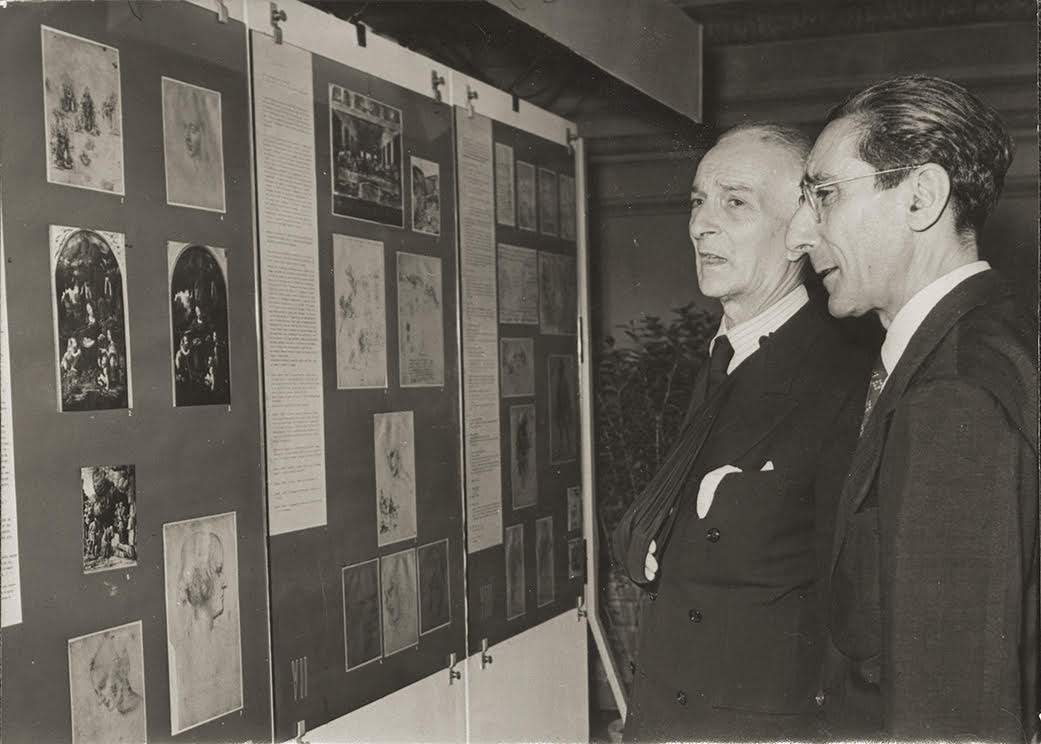The nationalist myth of Leonardo da Vinci, we also recounted on these pages, was born during the years of Fascism: Leonardo, raised to the summa of “Italic genius,” saw his popularity increase during the era of the Fascist regime, so much so that he became a sort of propaganda tool. Only after World War II would the groundwork be laid for a restitution of his figure to the truth of scientist, artist and inventor: decisive were the studies of Giorgio Castelfranco culminating in the didactic exhibition held in Rome in 1952.
The history of Leonardo’s critical fortune in twentieth-century Italy is now the subject of a documentary exhibition entitled Giorgio Castelfranco’s Leonardo and the Cult in the Genius in the Twentieth Century and set up in Florence, at Casa Siviero, from May 18 to September 29, 2019. The exhibition is the result of careful research that reconstructs the critical and exhibition events surrounding Leonardo in the last century. Great space is given precisely to the figure of Castelfranco, who was an official of the Florentine Soprintendenza and a victim of the Racial Laws, an art historian and then a monuments man together with Rodolfo Siviero. Castelfranco occupies a leading role in the panorama of 20th-century Italian culture, and he is therefore due the starring role in the exhibition promoted by the Region of Tuscany and curated by art historian Alessia Cecconi of the CDSE Foundation in collaboration with The Harvard University center for Italian Renaissance studies - Villa I Tatti, which preserves Castelfranco’s archives.
Castelfranco was also a discoverer, collector and great friend of Giorgio De Chirico, and he approached Leonardo since the 1930s, with some studies in that period marking a different clear-cut from the regime-inspired cultural climate that made of the scientist and artist a nationalistic symbol, the genius of the “Italic lineage” from which departed a glorious line of scientists culminating with Guglielmo Marconi, hero of Mussolini’s autarkic Italy. “The final fruit of this long research effort is the volume Studi Vinciani published in 1966 on the occasion of his retirement from his job at the Soprintendenza di Roma,” explains editor Alessia Cecconi, “Castelfranco focuses instead on Leonardo’s mentality, his relations with humanistic culture, his scientific, metaphysical, and aesthetic convictions, considered his true greatness.”
The Fascist regime dedicated a major exhibition to Leonardo in 1939 that was in fact nothing more than a propaganda show, set up unsparingly with two hundred models of Leonardo’s machines, and the articles devoted to the artist in La Difesa della Razza had transformed Leonardo, in spite of himself, into the champion of the genial Italic race. A perspective fortunately completely reversed after the fall of fascism. “In 1952,” Cecconi continues, “the first didactic exhibition on Leonardo da Vinci on the occasion of the five-hundredth anniversary of the artist’s birth curated by Giorgio Castelfranco was a real revolution. With a deliberately sober layout, which dialogued with elegant functional rigor with the rooms of the Sala Regia in Palazzo Venezia, the itinerary unfolded among luminous showcases and 48 thematic panels, which recounted the complexity of Leonardo’s cosmos through texts, quotations, details of paintings, drawings and photographs. The exhibition was involved in an unprecedented tour throughout Italy.”
“The exhibition,” stresses Monica Barni, “vice-president and councillor for Culture of the Region of Tuscany, ”continues the series of initiatives for the enhancement of the Casa Siviero Museum also as a place of memory of Giorgio Castelfranco, the scholar and art critic who in the period between the two world wars lived with his family in the small villa in Lungarno Serristori. A leading figure in the administrative reorganization and protection of Italy’s cultural heritage after September 8, 1943, Giorgio Castelfranco also made a major contribution to the critical study of Leonardo and the historically correct establishment of his reputation as a universal Renaissance genius. In the year in which we celebrate the five-hundredth anniversary of Leonardo’s death, this exhibition and catalog bring to light the importance of Giorgio Castelfranco’s Vincentian studies."
The exhibition can be visited on Saturdays from 10 a.m. to 6 p.m., Sundays and Mondays from 10 a.m. to 1 p.m. For all info visit the Rodolfo Siviero House Museum website or the CDSE Foundation website.
Pictured: Giorgio Castelfranco (left) with Antonio Segni, then minister of education, in 1952
 |
| Leonardo da Vinci as a Fascist propaganda myth (and then restored to truth). An exhibition in Florence |
Warning: the translation into English of the original Italian article was created using automatic tools. We undertake to review all articles, but we do not guarantee the total absence of inaccuracies in the translation due to the program. You can find the original by clicking on the ITA button. If you find any mistake,please contact us.